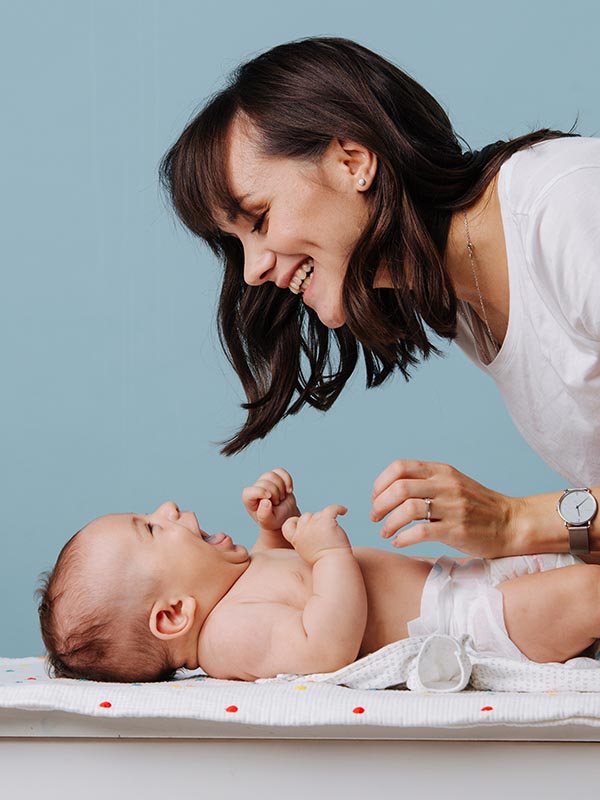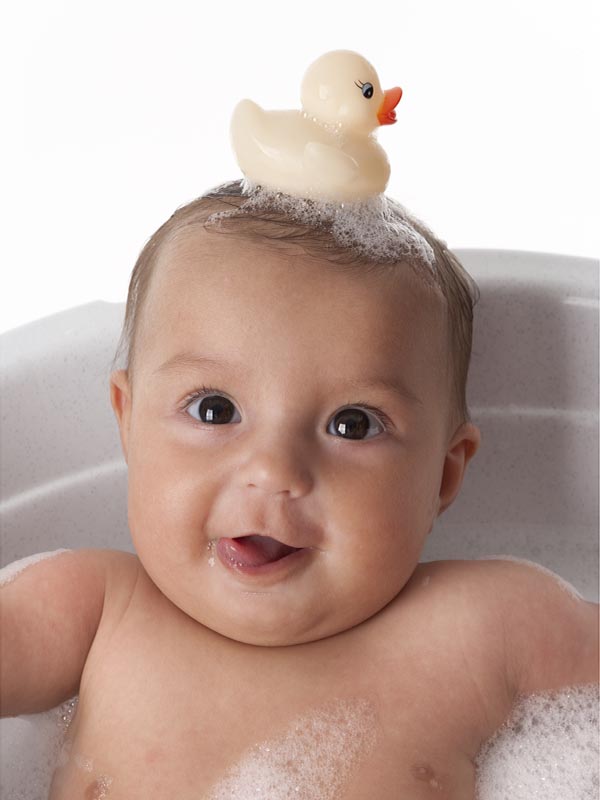

The little child wants and is able to communicate as a newborn. The baby seeks contact using voice, eyes, and movements, and the baby has already been actively listening to its mother while still in the womb. Therefore, language development begins very early, and there is much that we adults can do to help. Here are our best tips for building language together with small children, and the best part is that it is fun too!



Language play at the changing table
To learn, the child needs to interact with someone who knows a little more. A role model, someone to mimic, a safe embrace and a soothing voice
. Yes, someone who is close by and makes eye contact, and who sees me! At the changing table, we adults can easily take the opportunity to be a role model and build up the language. The closeness comes naturally, we are face to face and can make eye contact. It’s simply a matter of getting started! Here are some fun tips that are especially suitable when changing nappies:
- Talk about the body and what you are doing. “”And the little stomach, so clean and fine. And wipe here, and wipe there.””
- Find something nice to look at and talk about, maybe a poster or something else the child likes. Follow the child’s gaze, and put words to what you see. ”Dadda also has a nappy. Dadadadaaa! Dadda says.”
- Take the opportunity to babble and joke, tickle and smooch. Pause occasionally to see if the child wants to mimic or respond in another way.
- And why not include a nursery rhyme or song in between?


Language play in the bath
Language play can be used in all fun situations, and it usually is fun to bathe! Use the same words many times, for example “bathe”, both before, after and during the bath, with gestures and sounds like “splash, splash” – it can entice the child to mimic both gestures and sounds and eventually words. Other fun tips for when the child is to wash and bathe, are:
- Use fun toys to babble and language play with. Water play is fun! What does it sound like when the duck swims?
- Use rhymes and nursery rhymes, and sing – with things that suit the rhyme or song, you can build up the vocabulary even more effectively. “Quack, quack, little duck, jump into the water!”
- If you have to do something that is difficult, such as washing the hair, you can try to make it a game. “Shall we ask Doddo if we can have some shampoo?” At best, it is both language developing and makes the difficult task a little easier.


Language play at bedtime routines and sleep
The wildest language games may have to wait until the next day, but it is possible to sneak in a little language play and language stimulation in the evening routines too.
- Create a routine with a clear ritual, and put words to what you do. (First comes…, then we do…, now we will…) “First change the nappy, and then on with the pyjamas. Now we are going to brush teeth!”
- If brushing teeth is not the most fun the child knows, it is good to make up a little story at the same time. “One day when Babba was going to brush teeth, then Babba opened his mouth so wide! Can you do that? Yes, so wide!”
- A song or nursery rhyme can also make boring routines more fun.
- And don’t forget to bring a small book to bed! When the child is tired and wants to cuddle, it is very appropriate to show how cosy it is to read books. It doesn’t matter if you just flip a bit and look at the book and chat together, or if everyone has fallen asleep before the book is finished reading!


Language play at the dining table!
Chit-chatting and having conversations at the dining table probably feels natural for most of us! We sit together and have time to give each other attention. A tip if there are many in the family, is to try to ensure that everyone gets to tell something each day. And don’t forget yourself as a parent, because you are a role model for your children!
- When you converse and narrate, remember that we can tell things in many different ways. Try to include the youngest ones as well, but in their own way. For example, as an adult, you can recall something you saw in the park. “Remember the doggy? Woof, woof!” Give the child space to mimic or fill in with movements or sounds. Whether the child does it or not, he or she has received help to participate a bit in the conversation.
- It might be easier to find something to talk about and narrate when you have something fun to look at. Perhaps a placemat with the child’s favourite characters, a children’s dish set or a poster on the wall? It’s not always what happened today that’s the most fun to talk about, and with pictures nearby, it’s possible to point and show as well.
- Talk about what you’re doing right here and now, and about the food you’re eating. “This is delicious! Yum, yum.” When children start to express themselves a bit more with movements or words, we can also tempt them to put words on what they want. “Do you want water or milk?”


Play together!
Play is developing and fun! It’s almost impossible to find anything more language developing than playing together for a while. As adults, we usually just need to join in on what the child finds fun, and contribute with
new words, movements and sounds. If there is something special we want the child to learn, we can always find a little language game for that particular topic to support the child. Here are our best tips for fun and language developing play:
- Put words on what you see and do in the play. As an adult, you can constantly introduce some new words in the play to build up the vocabulary. It’s also nice to play with onomatopoeic words and sounds. For example, it’s almost always easier for children to start saying “meow” than “cat”.
- Small children often like simple “give and take games” and to play peek-a-boo, and from such games they learn the basis for other things in life. The “give and take game” provides practice for turn-taking, which is the basis that conversation is based on – we take turns to listen and talk.
- Use what the child is interested in, and sneak in some language play in it! One of the fundamental ideas behind Babblarna is to support the development of early language sounds. But when we come up with other games with Babblarna, they can also be used to stimulate other parts of the language. When Babblarna, for example, gets to play hide and seek, the child can develop understanding of the meaning of position words like “behind” and “under”. “Babba has hidden behind the sofa.”


Language play outdoors!
Out in the world, there’s a lot to look at for both big and small. Talk about everything you see – it provides endless opportunities to build up language. Here are our best tips for language developing moments outdoors:
- Follow the child’s gaze, and put words on what you see. “Look, a car. Wow, that car drove fast.”
- Make sure to create and mimic sounds together. What sound did the car make when it passed by? And what does the cat say?
- Talk about what you’re doing, and where you’re going. Maybe the child can also get to decide. Shall we walk or run to the park?

1 Put words to everything
Make it a habit to put words to everything you do in different situations, and talk about what you see. It is pleasant for the child to have this contact with you, and it also builds up vocabulary and language!
2 … but listen even more!
Also, pay attention to everything the child expresses themselves, with for example, sounds, movements, facial expressions, and eyes. The more responsive we adults are, the more little children can communicate with us. If we then interpret and put words to what we think the child is thinking, we can have a real, language-developing conversation – even before the child has said their first words.
3 Use gestures and signs
By using a lot of gestures, or signs, when we talk to the little ones, we reinforce what we say, and support language development. In this way, we also show how the child themselves can use their body to make themselves understood, before they can say a word. All forms of communication are good!
4 Babble away, and take turns making sounds!
With babbling, the child practices gaining control over all the small muscles we use when we talk. We adults can encourage this by playing with sound ourselves, and enticing the child to mimic us. Maintain eye contact, make funny little faces, and babble away – it may take a while for the child to “respond”, but suddenly it happens!
5 Read, sing, use rhymes and rules
Look at books together, let the child hear songs, rhymes, and rules, and use touch and tickling. Your child likes to hear your voice and simultaneously collects words, sounds, and the melody of language for the day when it’s time to start babbling themselves. There are endless situations in everyday life that are excellent for
playing with language. At the changing table, at the dining table, in the bath, at bedtime. Click on the circles above for more tips!
READ MORE
Nothing found.
TIPS!
Language play with Babblarna
Babblarna is more than a gang of colourful characters. Here you’ll find tips on how they can be used to play with language!

